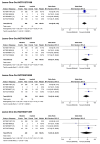Nilotinib Versus Imatinib in Philadelphia Chromosome-Positive Chronic Myeloid Leukemia (Ph+ CML): A Systematic Review and Meta-Analysis of Randomized Controlled Trials (RCTs)
- PMID: 40395267
- PMCID: PMC12091580
- DOI: 10.7759/cureus.82631
Nilotinib Versus Imatinib in Philadelphia Chromosome-Positive Chronic Myeloid Leukemia (Ph+ CML): A Systematic Review and Meta-Analysis of Randomized Controlled Trials (RCTs)
Abstract
Philadelphia-positive chronic myeloid leukemia (Ph+ CML) has witnessed significant advancements in treatment. Both nilotinib and imatinib have demonstrated potential in handling CML; however, a comprehensive evaluation of their comparative efficacy is crucial for optimizing treatment decisions. The primary objective of this study is to compare the rates of complete cytogenetic response (CCyR), major molecular response (MMR), and other clinical outcomes, including anemia, rash, and hyperbilirubinemia, in patients treated with either nilotinib or imatinib. An extensive literature search of reliable databases, including PubMed/MEDLINE, Scopus, clinicaltrials.gov, and Science Direct, was carried out to find the relevant literature. The subject headings and keywords searched were "imatinib", "nilotinib", "Ph+ chronic myeloid leukemia", and "Ph+ CML". A statistical analysis was done using RevMan 5.4.1 (Cochrane 2020). Pooled effects were used to estimate the odds ratio (OR), hazard ratios (HR), and risk ratios (RR) with a 95% confidence interval (CI). I2 statistics were used to assess for heterogeneity. A p-value ≤ 0.05 was considered statistically significant. A total of four studies with 1,045 patients were included in the study. Patients who received nilotinib had higher odds of achieving MMR at 12 months (OR 2.83; 2.12-3.79; p < 0.0001) and maintaining the MMR, i.e., durable MMR at 24 months (OR 2.72; 2.02-3.68; p < 0.0001) compared to patients on imatinib. Similar results were noted for CCyR at 12 months (OR 1.30; 0.60-2.81; p = 0.5). Overall, nilotinib was found to be superior due to better clinical outcomes, but adverse effects, like hyperbilirubinemia and rash, were significantly higher in nilotinib as compared with imatinib. With a paucity of quality studies conducted within this area, the clinical implications of our findings are limited. However, the use of nilotinib for Ph+ CML patients is an understudied area, with potential for clinical benefit over imatinib.
Keywords: imatinib; nilotinib; philadelphia chromosome-positive chronic myeloid leukemia (ph+ cml); randomized controlled trials (rcts); systematic review and meta-analysis.
Copyright © 2025, Zafar et al.
Conflict of interest statement
Conflicts of interest: In compliance with the ICMJE uniform disclosure form, all authors declare the following: Payment/services info: All authors have declared that no financial support was received from any organization for the submitted work. Financial relationships: All authors have declared that they have no financial relationships at present or within the previous three years with any organizations that might have an interest in the submitted work. Other relationships: All authors have declared that there are no other relationships or activities that could appear to have influenced the submitted work.
Figures








References
Publication types
LinkOut - more resources
Full Text Sources
